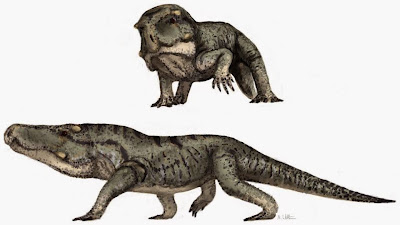 |
| Life reconstruction of Garjainia madiba sp. nov. Total adult body length would have been approximately 2.5 metres, based on comparisons with G. prima. Reconstruction by Mark Witton
|
Abstract
A new species of the erythrosuchid archosauriform reptile Garjainia Ochev, 1958 is described on the basis of disarticulated but abundant and well-preserved cranial and postcranial material from the late Early Triassic (late Olenekian) Subzone A of the Cynognathus Assemblage Zone of the Burgersdorp Formation (Beaufort Group) of the Karoo Basin of South Africa. The new species, G. madiba, differs from its unique congener, G. prima from the late Olenekian of European Russia, most notably in having large bony bosses on the lateral surfaces of the jugals and postorbitals. The new species also has more teeth and a proportionately longer postacetabular process of the ilium than G. prima. Analysis of G. madiba bone histology reveals thick compact cortices comprised of highly vascularized, rapidly forming fibro-lamellar bone tissue, similar to Erythrosuchus africanus from Subzone B of the Cynognathus Assemblage Zone. The most notable differences between the two taxa are the predominance of a radiating vascular network and presence of annuli in the limb bones of G. madiba. These features indicate rapid growth rates, consistent with data for many other Triassic archosauriforms, but also a high degree of developmental plasticity as growth remained flexible. The diagnoses of Garjainia and of Erythrosuchidae are addressed and revised. Garjainia madiba is the geologically oldest erythrosuchid known from the Southern Hemisphere, and demonstrates that erythrosuchids achieved a cosmopolitan biogeographical distribution by the end of the Early Triassic, within five million years of the end-Permian mass extinction event. It provides new insights into the diversity of the Subzone A vertebrate assemblage, which partially fills a major gap between classic ‘faunal’ assemblages from the older Lystrosaurus Assemblage Zone (earliest Triassic) and the younger Subzone B of the Cynognathus Assemblage Zone (early Middle Triassic).
David J. Gower, P. John Hancox, Jennifer Botha-Brink, Andrey G. Sennikov and Richard J. Butler. 2014. A New Species of Garjainia Ochev, 1958 (Diapsida: Archosauriformes: Erythrosuchidae) from the Early Triassic of South Africa. PLoS ONE.
DOI: 10.1371/journal.pone.0111154.g030
DOI: 10.1371/journal.pone.0111154.g030